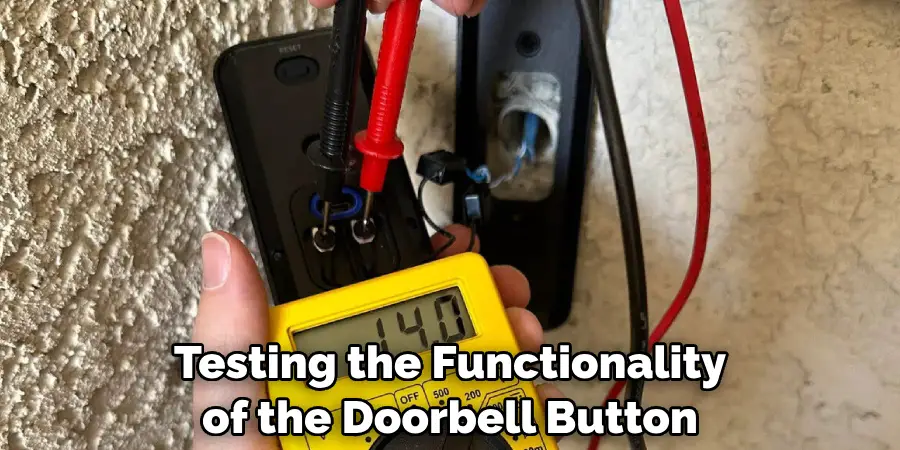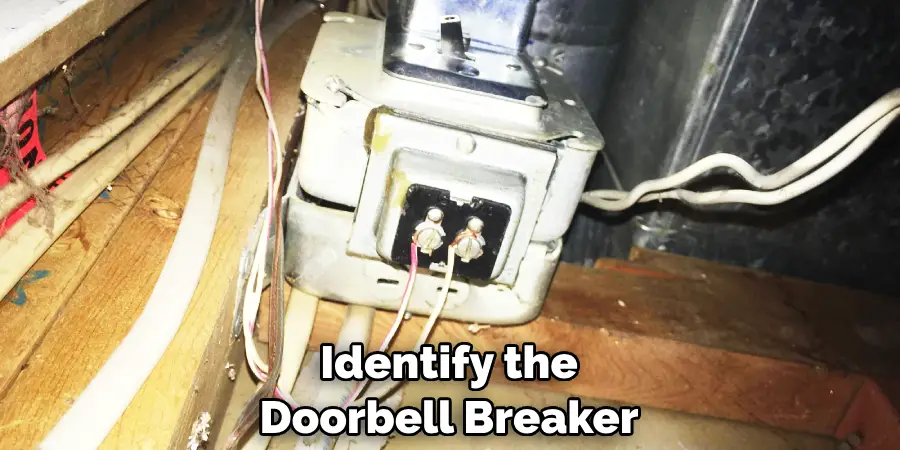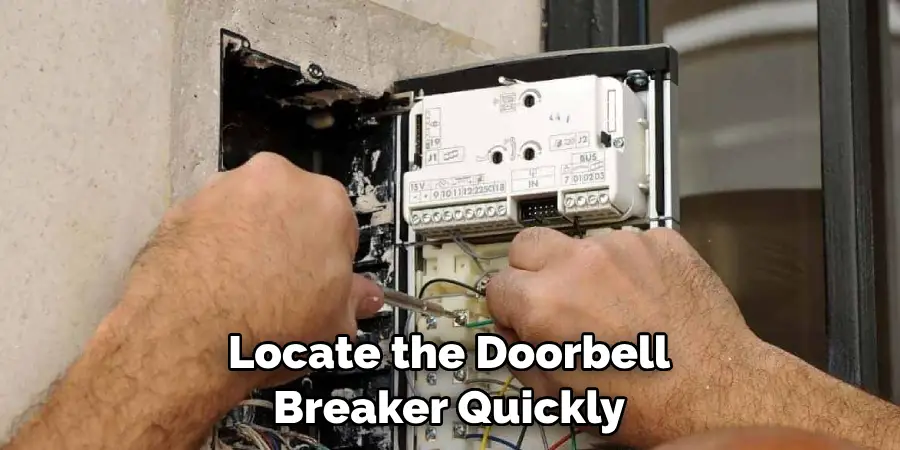Finding the breaker that controls your doorbell is a crucial step in troubleshooting issues such as malfunctions or the need for replacements. Locating the doorbell breaker not only ensures safety during maintenance but also saves time by pinpointing the specific circuit to address.
In this guide, we’ll explore various methods and techniques for how to find doorbell breaker. From systematic testing of circuit breakers to using specialized tools like voltage detectors, each approach offers a pathway to efficiently isolate the correct breaker.

Whether you’re a seasoned DIY enthusiast or a homeowner tackling electrical tasks for the first time, understanding how to find the doorbell breaker empowers you to navigate electrical systems confidently and resolve doorbell-related issues effectively.
Significance of A Functioning Doorbell
A functioning doorbell is more than just a means of announcing visitors; it is a crucial component of home security and convenience. For many, the doorbell is the first line of communication with someone outside, allowing homeowners to identify and interact with visitors without needing to open the door.
This aspect is especially significant in the context of increasing concerns about home security. Additionally, with the rise of online shopping and home deliveries, a working doorbell ensures that parcels and services are received promptly, minimizing the risk of missed deliveries.
For those with mobility issues, a functioning doorbell paired with smart home technology can provide remote access to greet guests or service personnel, highlighting its role in making homes more accessible.
Common Issues Leading to Doorbell Failure
Doorbell failures can stem from a variety of issues, some of which are simple to fix, while others might require more in-depth electrical knowledge or the assistance of a professional. One of the most common causes of doorbell malfunction is wiring problems. Over time, wires can become loose, frayed, or disconnected, preventing the doorbell from functioning properly.
Another frequent issue is a malfunctioning transformer, which can fail to supply the necessary power to the doorbell. Additionally, the doorbell button itself can wear out from use or weather exposure, causing it to stick or break.
In modern homes, wireless doorbells may experience interference from other devices or simply run out of battery, leading to operation failures. Understanding these common issues can help homeowners diagnose doorbell problems more effectively and decide on the appropriate course of action, whether it be a simple repair or a complete replacement.
Understanding the Doorbell System
A basic comprehension of the doorbell system is essential for diagnosing and troubleshooting issues effectively. The traditional doorbell setup consists of four key components: the push button, the wiring, the transformer, and the chime box.

When the doorbell button is pressed, it closes the circuit, allowing electricity to flow from the transformer through the wires to the chime box, which then produces the familiar ringing sound. The transformer’s role is critical; it reduces the standard home voltage to a lower level that’s safe for the doorbell circuit.
Modern systems might incorporate more sophisticated elements, including wireless technology that eliminates the need for direct wiring and allows for integration with smart home devices. Understanding these components and their interactions is vital in pinpointing the root cause of doorbell issues and ensuring any maintenance or replacements are executed safely and effectively.
Components of a Typical Doorbell System
To effectively troubleshoot and maintain a doorbell system, it’s important to understand the components that comprise it. A typical doorbell system includes:
- Push Button: The exterior component that initiates the doorbell’s operation. When pressed, it closes the electrical circuit, allowing power to flow through the system.
- Transformer: Converts high-voltage electricity from your home’s electrical system to a lower voltage suitable for the doorbell circuit. This ensures safety and compatibility.
- Wiring: Electrical wires connect the transformer, push button, and chime box. These wires carry the low-voltage electricity throughout the system.
- Chime Box: The interior component that produces the sound when the doorbell is pressed. The chime box can vary in complexity, offering different tones or melodies depending on the model.
- Power Source: This can be the home’s electrical system for wired doorbells or batteries for wireless models. The power source is crucial for the doorbell’s functionality.
- (Optional) Wireless Receiver: In wireless doorbell systems, a receiver replaces the need for direct wiring between components. It receives signals from the push button and activates the chime.
Familiarity with these elements is essential for anyone looking to repair or upgrade their doorbell system, ensuring efficient and effective maintenance.

Different Types of Doorbell Wiring Configurations
Doorbell wiring configurations can vary significantly based on the complexity and features of the system installed. Understanding these variations is crucial for troubleshooting and when considering upgrades or replacements. Here are the most common types of doorbell wiring configurations:
- Single Doorbell, Single Button: The simplest form of doorbell wiring involves a direct connection from the transformer to a single doorbell and one push button. This configuration is straightforward and typically found in smaller homes or those with a single entry point.
- Single Doorbell, Multiple Buttons: In homes with multiple entrances, it’s common to have several push buttons connected to a single doorbell. This setup allows the doorbell to be triggered from different points, such as the front and back doors. The wiring from each button is connected to the same chime box but may require a slightly higher capacity transformer to handle multiple inputs.
- Multiple Doorbells, Multiple Buttons: Larger homes or multi-family dwellings may have several doorbells, each with its corresponding button, wired to their own transformer. This configuration allows for different chimes or melodies to be assigned to each button, helping residents identify from which entrance a visitor is calling.
- Intercom Systems: Modern homes might incorporate intercom systems that integrate the doorbell with voice or video communication. These systems require additional wiring to support the transmission of audio or video signals from the external push button to the interior monitor.
- Wireless Doorbell Systems: While not involving traditional wiring, wireless doorbell systems are increasingly popular for their ease of installation and flexibility. These systems rely on radio signals transmitted from the push button to a receiver inside the house, which then triggers the chime.
Testing the Doorbell Button for Functionality
Testing the functionality of the doorbell button is a crucial step in diagnosing and troubleshooting doorbell issues. To accurately assess whether the button is operating as it should, follow these simple steps:

- Visual Inspection: Begin with a visual inspection of the doorbell button for any obvious signs of damage, wear, or weather-related effects. Look for cracks, accumulated debris, or anything that might hinder its operation.
- Listen for Click Sound: Gently press the doorbell button and listen for a distinct click sound, indicating that the button is mechanically completing the circuit. A lack of this sound could mean that the button is stuck or broken.
- Test with Multimeter: Turn off the power to your doorbell system at the circuit breaker. Use a multimeter set to the continuity setting, and attach its leads to the two screws on the back of the doorbell button. Press the button again; if the multimeter shows continuity (usually indicated by a beep or a change in reading), the button itself is working correctly. No continuity suggests that the button may need to be replaced.
- Check for Loose or Corroded Connections: While the power is off, inspect the connections at the back of the button for any loose wires or signs of corrosion. Clean any corrosion found with a small brush or replace wires that are significantly damaged.
- Bypass the Button: If you suspect the button is the issue but the above tests have not been conclusive, you can briefly bypass the button by touching the two wires together that connect to the button terminals. If the doorbell rings when the wires are touching, the issue likely lies with the button itself.
- Reassemble and Test: After performing your inspections and tests, reassemble the doorbell button if it has been found functional. Turn the power back on and test the system by pressing the button as usual.
10 Methods How to Find Doorbell Breaker
1. Check the Electrical Panel Labels:
Begin by examining the labels on your electrical panel. In many cases, the circuit breakers will be labeled with the corresponding areas or appliances they control. Look for labels such as “doorbell,” “chime,” or “bell” to identify the breaker that controls your doorbell circuit.
If the panel is not labeled, move on to the next method. While this method may take some time and trial-and-error, it will ensure that you correctly identify the correct breaker for your doorbell.
2. Test Breakers Systematically:
If your electrical panel is not labeled or if the doorbell breaker label is unclear, you can systematically test each breaker to identify the one that controls the doorbell circuit. Start by turning off one breaker at a time and then checking if the doorbell stops working. Proceed through each breaker until you find the one that controls the doorbell.

Once you have identified the correct breaker, make sure to label it clearly so it can be easily located in the future. This will save time and confusion when troubleshooting any issues with your doorbell system.
3. Use a Circuit Finder Tool:
Circuit finder tools, also known as circuit tracers or toners, are handheld devices that can help you locate specific circuits in your electrical panel. To use a circuit finder, plug the transmitter into an outlet or light fixture on the doorbell circuit and then use the receiver to scan the breakers in the electrical panel.
The receiver will emit a signal or tone when it detects the correct breaker. This eliminates the need for trial and error, saving you time and frustration.
Circuit finder tools are especially useful when dealing with large electrical panels or complex wiring systems. They can also be helpful when troubleshooting issues with specific circuits, such as a tripped breaker that is not labeled correctly. Instead of having to turn off multiple breakers to find the correct one, a circuit finder can pinpoint it quickly and accurately.
4. Test Voltage with a Multimeter:
Another method to find the doorbell breaker is to test the voltage at the doorbell transformer. Begin by locating the transformer, which is usually mounted on or near the electrical panel. Use a multimeter to test the voltage across the transformer terminals. Then, turn off one breaker at a time and retest the voltage until it drops to zero, indicating the breaker that controls the doorbell circuit.
Once you have identified the correct breaker, turn it off and label it as the doorbell breaker. This will ensure that you do not accidentally turn it back on while working on the doorbell wiring.
5. Follow the Doorbell Wiring:
Trace the wiring from the doorbell button to the transformer and then to the electrical panel. Look for any junction boxes or splices along the way where the wiring may be connected to a specific circuit. By visually tracing the wiring path, you may be able to determine which breaker controls the doorbell circuit.
Once you have identified the circuit, turn off the breaker to ensure the power is completely cut off. This will ensure your safety while working on the doorbell wiring.

Next, carefully remove the cover of your doorbell button and check for any loose or damaged wires. If you notice any issues, make sure to fix them before proceeding.
6. Inspect the Chime or Transformer:
In some cases, the doorbell chime or transformer may be labeled with the corresponding breaker number or circuit designation. Check the labels on these components to see if they provide any clues about the location of the doorbell breaker in the electrical panel.
If the labels do not provide any information, you can use a multimeter to test for voltage on each breaker in the panel. This will help you identify which breaker controls the doorbell circuit.
7. Consult Building Plans or Documentation:
If you have access to the building plans or documentation for your home, check if they include information about the electrical layout, including the location of the doorbell circuit breaker.
This can be especially helpful if the electrical panel is not easily accessible or if the labeling is incomplete or outdated. Though it may seem like a hassle, taking the time to consult these documents can save you from potential headaches and safety hazards in the future.
You can also look for online resources or forums where homeowners share their experiences with doorbell wiring. This can provide valuable insights and tips on troubleshooting or upgrading your existing system. Additionally, hiring a licensed electrician to review your building plans and advise on any necessary changes can provide peace of mind and ensure your doorbell system is up to code.
8. Ask Previous Homeowners or Contractors:
If you recently purchased the home or if it was built by a previous owner, consider reaching out to them or any contractors who may have worked on the electrical system. They may have knowledge or records that can help you identify the doorbell breaker or provide insights into the electrical layout of the home. This can save you time and effort in troubleshooting the issue.

9. Use a Non-Contact Voltage Detector:
Non-contact voltage detectors are handy tools that can detect the presence of electrical voltage without making direct contact with the wires or terminals. To use a non-contact voltage detector, hold the device near the electrical panel while scanning the breakers. The detector will emit an audible or visual alert when it detects voltage, helping you identify the breaker that controls the doorbell circuit.
These detectors are useful for a variety of electrical projects and can also be used to test outlets, switches, and light fixtures. They are especially helpful for beginners or those who have limited experience working with electricity.
10. Seek Professional Assistance:
If you’re unable to locate the doorbell breaker on your own or if you’re uncomfortable working with electrical systems, consider hiring a licensed electrician to assist you.
A professional electrician will have the knowledge, experience, and tools to safely and accurately identify the doorbell breaker and address any related issues or concerns. This may also be a good option if you have an older home with outdated wiring or outdated doorbell systems.
Additionally, hiring a professional can save you time and potential frustration. They will be able to locate the doorbell breaker quickly and efficiently, without causing any damage to your home’s electrical system. Plus, they can provide advice on upgrading your doorbell system or making any necessary repairs.

Conclusion
In conclusion, locating a doorbell breaker can seem daunting, but with the systematic approach outlined in this guide, homeowners can tackle the task with confidence.
By understanding the components of their doorbell system, identifying the circuit breaker panel, and employing a methodical process of elimination, individuals can effectively pinpoint the breaker controlling their doorbell. It’s essential to remain patient and thorough during the search, ensuring safety precautions are followed at all times.
Remember, troubleshooting doorbell issues may require persistence and possibly the assistance of a professional electrician, especially in cases of inaccessible or unlabeled breaker panels. Thanks for reading, and we hope this has given you some inspiration on how to find doorbell breaker!
